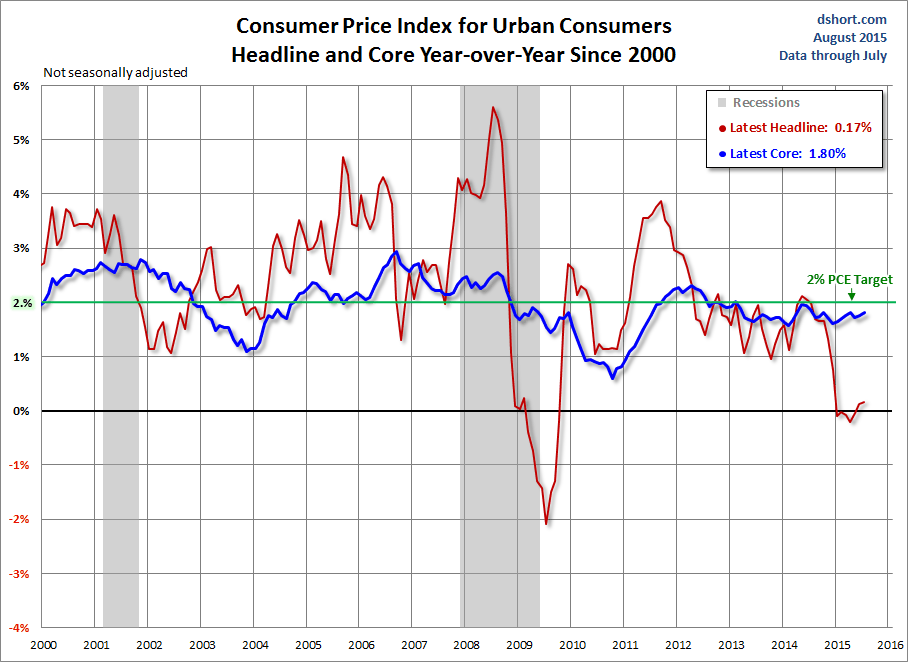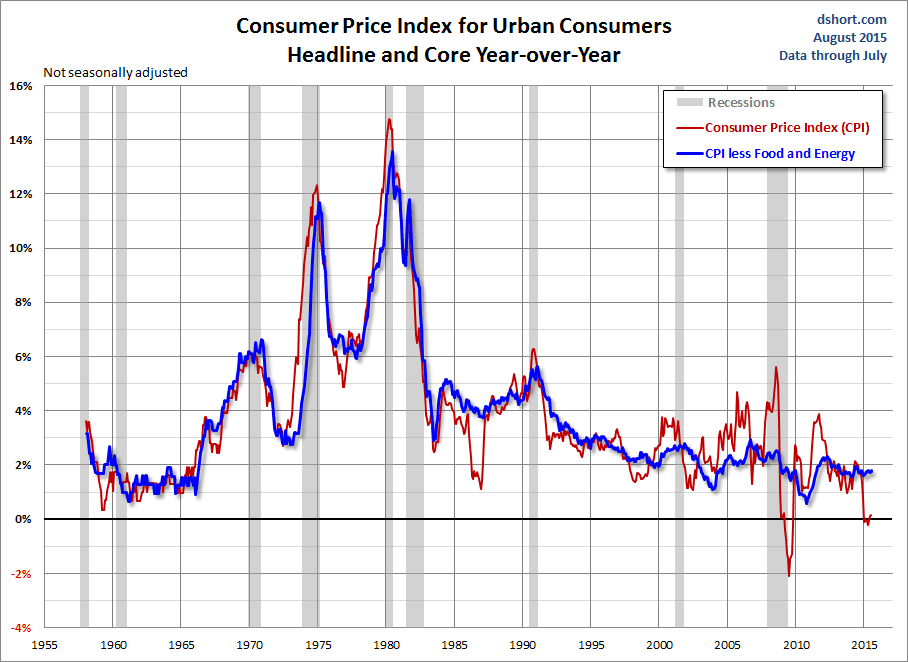The Bureau of Labor Statistics released the July CPI data this morning. The year-over-year unadjusted headline CPI came in at 0.17% (rounded to 0.2%), up from 0.12% (rounded to 0.1%) the previous month. Year-over-year core CPI (ex. food and energy) came in at 1.80%, essentially unchanged from the previous month's 1.76% (rounded to 1.8%).
Here is the introduction from the BLS summary, which leads with the seasonally adjusted monthly data:
The Consumer Price Index for All Urban Consumers (CPI-U) increased 0.1 percent in July on a seasonally adjusted basis, the U.S. Bureau of Labor Statistics reported today. Over the last 12 months, the all items index rose 0.2 percent before seasonal adjustment.
The indexes for food, energy, and all items less food and energy all rose slightly in July. The food index rose 0.2 percent as all six major grocery store food group indexes increased. The energy index rose 0.1 percent as an increase in the gasoline index more than offset declines in other energy component indexes.
The index for all items less food and energy also rose 0.1 percent in July. A 0.4-percent advance in the shelter index was the main contributor to the increase, though the indexes for medical care and apparel also rose. In contrast, the index for airline fares fell sharply, and the indexes for used cars and trucks, household furnishings and operations, and new vehicles all declined.
The all items index increased 0.2 percent for the 12 months ending July. The 12-month change has been rising since April. The index for all items less food and energy increased 1.8 percent for the 12 months ending July; this was the fourth time in 5 months the 12-month change was 1.8 percent. The food index increased 1.6 percent over the last 12 months. The energy index, however, continues to show a 12-month decline, falling 14.8 percent over the past year. [More…]
Investing.com was looking for a 0.2% increase in both the seasonally adjusted headline and core CPI. Year-over-year forecasts were 0.2% for headline and 1.8% for core.
The first chart is an overlay of headline CPI and core CPI (the latter excludes food and energy) since the turn of the century. The highlighted two percent level is the Federal Reserve's core inflation target for the CPI's cousin index, the BEA's personal consumptions expenditures (PCE) price index.

The next chart shows both series since 1957, which was the first time the government began tracking core inflation.

In the wake of the Great Recession, two percent has been the Fed's target for core inflation. However, at their December 2012 FOMC meeting, the inflation ceiling was raised to 2.5% while their accommodative measures (low Fed Funds Rate and quantitative easing) were in place. They have since reverted to the two percent target in their various FOMC documents.
Federal Reserve policy, which in recent history has focused on core inflation measured by the core PCE price index, will see that the more familiar core CPI remains below the PCE target range of 2 percent.
Which stock should you buy in your very next trade?
With valuations skyrocketing in 2024, many investors are uneasy putting more money into stocks. Unsure where to invest next? Get access to our proven portfolios and discover high-potential opportunities.
In 2024 alone, ProPicks AI identified 2 stocks that surged over 150%, 4 additional stocks that leaped over 30%, and 3 more that climbed over 25%. That's an impressive track record.
With portfolios tailored for Dow stocks, S&P stocks, Tech stocks, and Mid Cap stocks, you can explore various wealth-building strategies.
